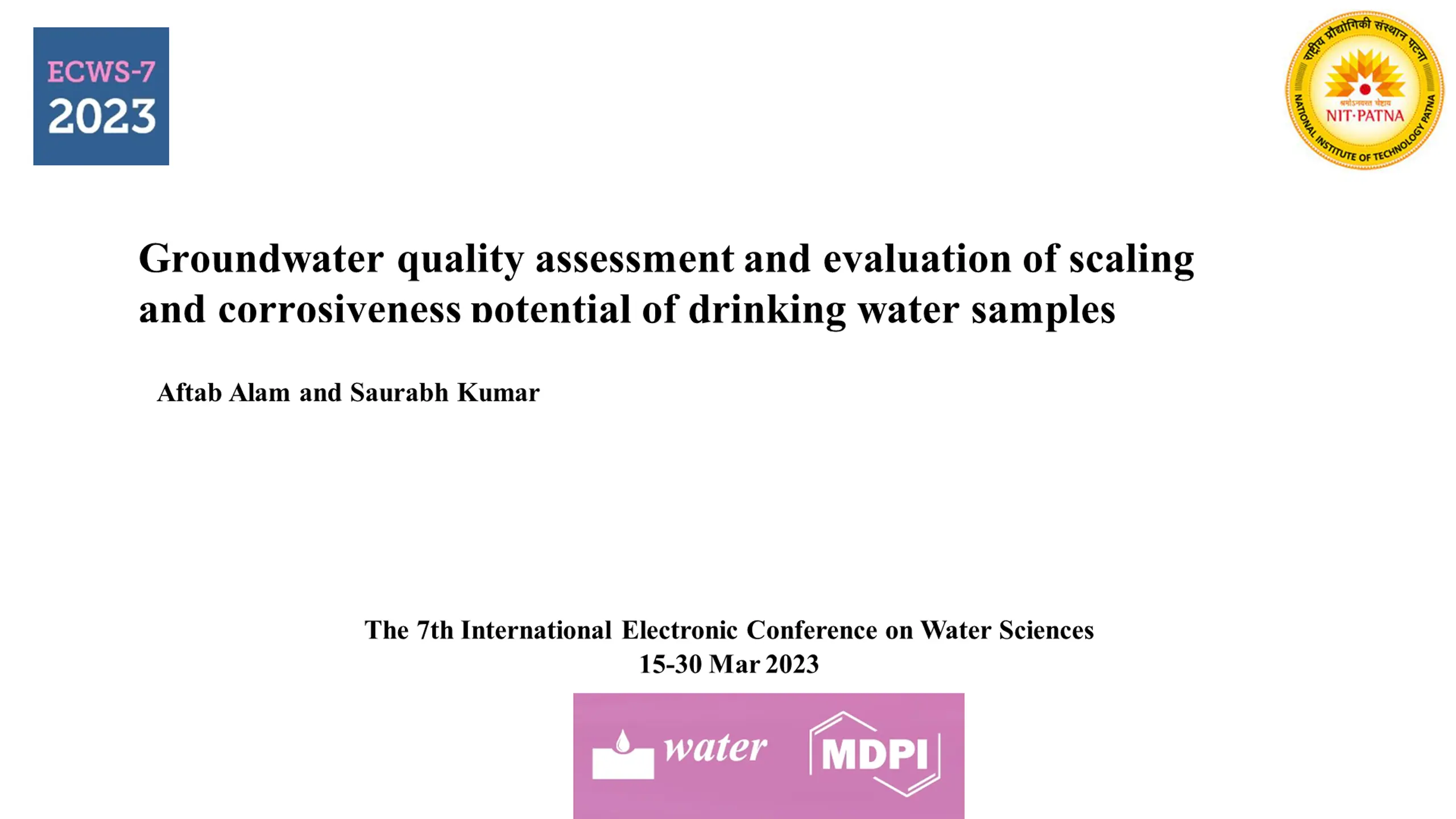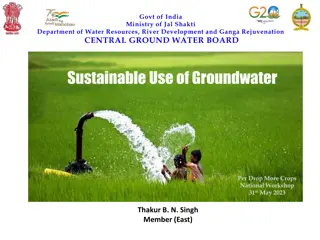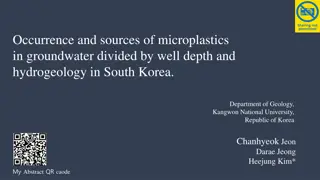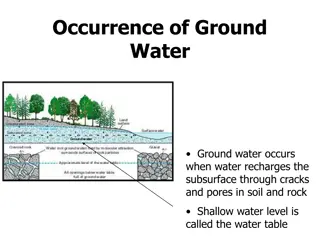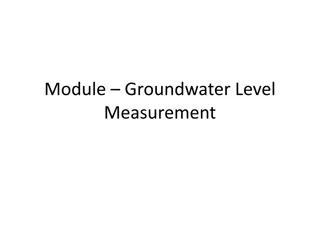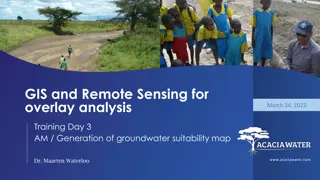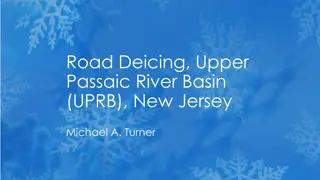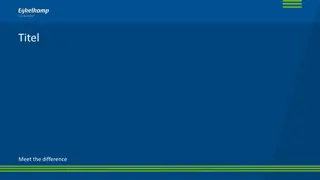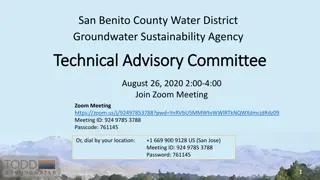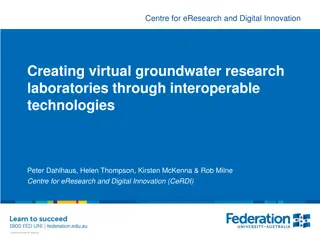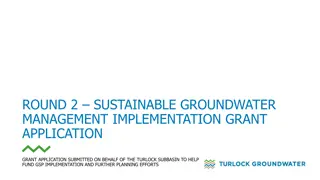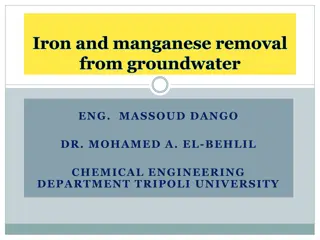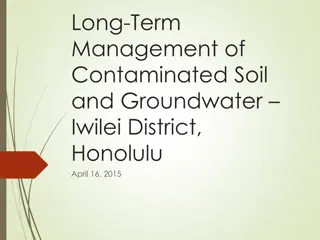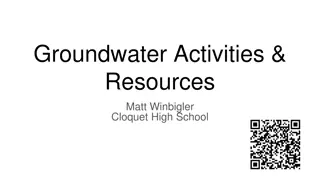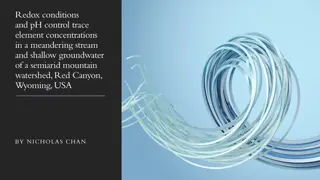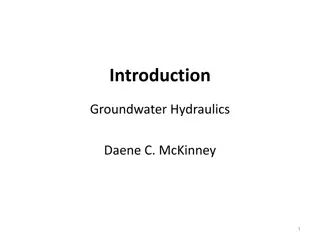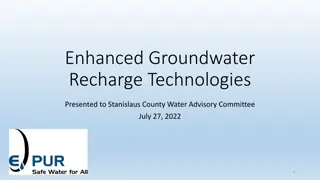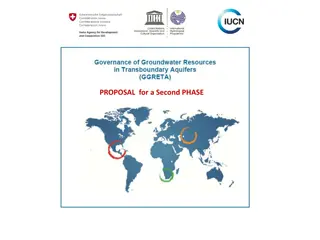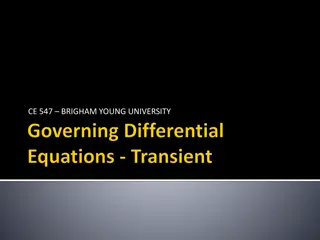Groundwater Quality Assessment & Corrosiveness Evaluation
Explore groundwater quality using WQI & corrosion indices. Study in Bihar, India aids in sustainable management approaches.
Download Presentation

Please find below an Image/Link to download the presentation.
The content on the website is provided AS IS for your information and personal use only. It may not be sold, licensed, or shared on other websites without obtaining consent from the author.If you encounter any issues during the download, it is possible that the publisher has removed the file from their server.
You are allowed to download the files provided on this website for personal or commercial use, subject to the condition that they are used lawfully. All files are the property of their respective owners.
The content on the website is provided AS IS for your information and personal use only. It may not be sold, licensed, or shared on other websites without obtaining consent from the author.
E N D
Presentation Transcript
Groundwater quality assessment and evaluation of scaling and corrosiveness potential of drinking water samples Aftab Alam and Saurabh Kumar The 7th International Electronic Conference on Water Sciences 15-30 Mar 2023
Content 1. Introduction 2. Objective 3. Study Area 4. Material and Methods 5. Results and Discussion 6. Conclusion 7. References The 7th International Electronic Conference on Water Sciences 15-30 Mar 2023
Introduction Groundwater is an essential source for domestic and industrial purposes. Population growth has resulted in a massive increase in groundwater demand . WQI method is widely used around the world for groundwater quality assessment. Water corrosion and scaling can be predicted with analytical terminology such as Ryznar stability index (RSI), Aggressive index (AI), Langelier saturation index (LSI), Larson- Skold index (LS), and Puckorius scaling index (PSI). The 7th International Electronic Conference on Water Sciences 15-30 Mar 2023
Objective To assess the groundwater quality and corrosive potential of drinking water samples. Which help in managing future sustainable groundwater management approaches in the Aurangabad District, Bihar (India). The 7th International Electronic Conference on Water Sciences 15-30 Mar 2023
Study Area Longitudes 84o00' - 84o45 E Latitudes 24o30' - 25o15' N. The 7th International Electronic Conference on Water Sciences 15-30 Mar 2023
Materials and Methods Sampling and Data Analysis Water Quality Index Corrosiveness Indices All the procedures followed as per APHA 2017. WQI is a rating that assesses the impact of several parameters on water quality. the calculation of WQI, all stages were performed as described by Horton et. Al. 1965. LSI, RSI, PSI, Ls, and AI were used to assess the corrosion potential of water samples. There were seven physicochemical parameters that were used in calculating these indices: pH, temperature, TDS, alkalinity, calcium hardness, chloride, sulfate. The 7th International Electronic Conference on Water Sciences 15-30 Mar 2023
Index Equation Index value Tendency of Water Langelier saturation index (LSI) LSI= pH-pHs pHs = (9.3 +A +B)- (C+ D) A= (Log (TDS)-1)/10 B= -13.2(Log ( +273)) + 34.55 C= Log (Ca++ as CaCO3) 0.4 D= Log (Alkalinity as CaCO3) RSI= 2pHs -pH LSI<0 LSI=0 LSI>0 Corrosive tendency Neutral tendency Scaling tendency Contd.. Ryznar stability index (RSI) RSI<5.5 5.5<RSI<6.2 6.2<RSI<6.8 6.8<RSI<8.5 RSI>8.5 High Scaling tendency Scaling tendency Neutral tendency Low corrosive tendency High Corrosive tendency Corrosive tendency Scaling tendency High corrosive tendency Corrosive tendency Scaling tendency Equations and classification of Corrosiveness indices. Puckorius scaling Index (PSI) PSI= 2pHs- pHeq pHeq=1.465log (Alkalinity) +4.54 Alkalinity= HCO3- +2(CO3-) +OH- Ls=(??? +???4 PSI>7 PSI<6 Larson-Skold Index (Ls) Ls>1.2 0.8<Ls<1.2 Ls<0.8 2 )/ (????3 + ???3 2 ) C= Concentration in mg/L Aggressive index (AI) AI= pH + log ((Ca++) (Alkalinity)) AI<10 10<AI<12 AI>12 Corrosive tendency Moderately Corrosive Scaling tendency The 7th International Electronic Conference on Water Sciences 15-30 Mar 2023
Results and Discussion Statistical analysis results on the study area groundwater data pH TDS (mg/L) EC DO F- Cl- NO3- (mg/L) SO42- (mg/L Alk. (mg/L) TH Ca2+ Mg2+ (mg/L) ( S/cm) (mg/L) (mg/L) (mg/L) (mg/L) (mg/L) Min 6.67 7.06 7.24 7.26 7.53 7.84 7-8 139.0 287.0 340.2 369.8 387.9 839.0 600 242.5 530.3 645.0 721.8 771.9 1669.0 1.15 1.71 2.05 2.02 2.24 2.89 0.10 0.52 0.71 0.90 1.11 2.20 1.5 16.81 33.02 40.13 51.55 63.72 169.28 250 2.791 11.45 18.64 21.63 31.06 49.34 3.85 9.38 15.78 15.28 18.48 38.69 250 14.66 34.65 39.24 39.91 47.34 58.81 133.5 201.5 276.3 298.7 351.1 704.6 200 82.89 139.30 161.18 176.43 184.20 492.74 100 36.84 54.11 101.31 122.32 174.99 290.12 1st Qu. Median Mean 3rd Qu. Max. WHO - - 50 - - The 7th International Electronic Conference on Water Sciences 15-30 Mar 2023
Contd The 7th International Electronic Conference on Water Sciences 15-30 Mar 2023
Corrosiveness indices 87.5% of water samples were strong corrosive potential. All water samples were corrosive 93.75% of water sample were moderately corrosive. The 7th International Electronic Conference on Water Sciences 15-30 Mar 2023
Corrosiveness indices All water samples were corrosive 75% of the water samples have a strong corrosive tendency The 7th International Electronic Conference on Water Sciences 15-30 Mar 2023
Conclusions WQI of groundwater samples revealed that 75% had excellent or good water, and 25% either had poor or very poor water. LSI and RSI are the main indicators that are utilized for corrosion monitoring in iron and steel pipes. LSI indicates that all water samples had a corrosive tendency, and RSI indicates 87.5% high corrosive tendency. Chloride and sulfate ions corrode iron and steel pipes and degrade water quality. Ls is also a good tool for monitoring corrosion in iron and steel pipes. In water samples, Ls indicates a 75% high corrosive tendency, an 18.75% corrosive tendency, and a 6.25% scaling tendency. All these indices indicate that water has a corrosive tendency, which can degrade materials and affect water quality. The 7th International Electronic Conference on Water Sciences 15-30 Mar 2023
References 1. Wekesa, A. M. Assessment of Groundwater Quality Using Water Quality Index from Selected Springs in Manga Subcounty, Nyamira County, Kenya. The Scientific World Journal 2022. 2. Adimalla, N.; Qian, H. Groundwater quality evaluation using water quality index (WQI) for drinking purposes and human health risk (HHR) assessment in an agricultural region of Nanganur, south India. Ecotoxicology and Environmental Safety 2019, 126, 153 161. 3. K. Pietrucha-Urbanik, D. Skowro ska, and D. Papciak, Assessment of corrosion properties of selected mineral waters, Coatings, vol. 10, no. 6, pp. 1 13, 2020, doi: 10.3390/COATINGS10060571. 4. Kumar, S.; Singh, R. Qualitative assessment and corrosiveness of the Ganga water: A comparative assessment. Materials Today: Proceedings, 2021 45, 5695 5701. 5. APHA 2017, Standard Methods for the Examination of Water and Wastewater, 23rd Ed., 2017 American Public Health Association Washington. DC, USA. 6. Horton, R. K. An index number system for rating water quality, J Water Pollut Control fed, 1965, 3, 300-306. 7. Asadi, E.; Isazadeh, M.; Samadianfard, S.; Ramli, M. F.; Mosavi, A.; Nabipour, N.; Shamshirband, S.; Hajnal, E.; Chau, K. W. Groundwater quality assessment for sustainable drinking and irrigation. Sustainability (Switzerland), 2020, 1, 1 13. 8. WHO. (2006). WHO guidelines for drinking-water quality. Vol. 11, Issues 3 4, p. 515. 9. Langelier, W. F. The Analytical Control of Anti-Corrosion Water Treatment. American Water Works Association, 1936, 10, 1500 1521. 10.Ryznar, J. W. (1944). A New Index for Determining Amount of Calcium Carbonate Scale Formed by a Water. American Water Works Association, 1944, 4, 472 483. 11.Kumar, S.; Singh, R.; & Maurya, N. S. Water Quality Analysis and Corrosion Potential in the Distribution Network Patna, Bihar. Journal of Environmental Engineering and Science, 2022, 4, 164-174. 12.Kumar, S.; Singh, R.; & Maurya, N. S. Assessment of Corrosion Potential Based on Water Quality Index in the Distribution Network of urban Patna, Bihar, India. Journal of Nature Environment and Pollution Technology, 2022, 5, 2117-2127. The 7th International Electronic Conference on Water Sciences 15-30 Mar 2023
The 7th International Electronic Conference on Water Sciences 15-30 Mar 2023
